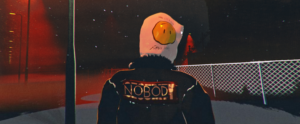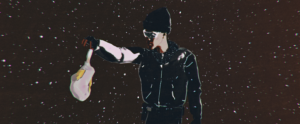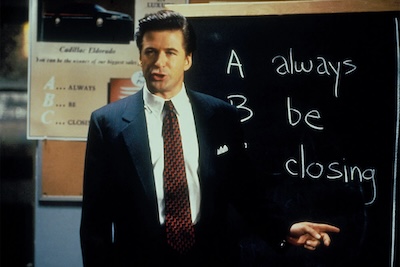You can almost hear the wind whistling through the darkness in Nadia Hallgren and Jamie-James Medina’s stunning and emotional animated short film contender, The Brown Dog. We may only focus on one man–dubbed Nobody–but this film speaks to our universal pangs of loneliness and isolation. Featuring a stunning voiceover turn from the late Michael K. Williams, The Brown Dog will linger in your thoughts long after the credits roll.
The Brown Dog centers on one security guard as he logs his observations during his seemingly routine shifts. Anyone he encounters stays at a distance, reigniting our collective wounds from the pandemic that raged only a few years ago. Every night, Nobody hunts for an elusive brown dog that occasionally crosses his path. Maybe he doesn’t even know what the canine means to him yet, but Nobody is searching for something meaningful and true. Medina explains how this beautiful short went through multiple iterations before becoming a winner at this year’s Indy Shorts International Film Festival.
“It’s lived in a couple of different mediums,” Medina says. “It began as a short story that was a series of security logs that the writer had written during his time as a guard. I took those logs and adapted them into the raio play, and we cast Michael K. Williams for that. The play was longer and a little slower, and it was about the tedium of shift work. The text carried a feeling of loneliness and isolation, which we ran with, and post-pandemic, I just started to think about that character all the time. For me, the prose and the character stayed with me. In 2021, we tried to rethink about what we could do with it and adapting it.”
 As Nobody begins and ends each one of his shifts, the seemingly mundane tasks add up to something unexpectedly moving. I revealed to the co-directors that their film and Nobody’s Journey hinted at an experience that we all shared in one way or another. Hallgren was quick to note that everyone has a personal story, even if we think we are just trying to get through the day to day.
As Nobody begins and ends each one of his shifts, the seemingly mundane tasks add up to something unexpectedly moving. I revealed to the co-directors that their film and Nobody’s Journey hinted at an experience that we all shared in one way or another. Hallgren was quick to note that everyone has a personal story, even if we think we are just trying to get through the day to day.
“With the pandemic, it made me think a lot about the lives of service workers and the individuals who have jobs that many people seem to have taken for granted for a long time,” Hallgren says. “Those people became the essential workers, the people that if they didn’t show ip for work, our lives didn’t function. They were actually the people who were providing people with more means and the ability to have a comfortable life as this pandemic raged on. We had a lot of conversations about that. We’re both in New York City, and that was such a huge part of life here since everything shut down. Looking at my background as a documentary filmmaker and a cinematographer, some of my favorite things to film were these seemingly mundane tasks that people perform daily. You can add beauty to that and lay a deeper context. We tied both of our experiences together to develop the Nobody character. I actually worked in security before I was able to make a living as a filmmaker, so there was another layer of connection that I have to that character. You try to pass the time through imagination and try to find yourself through other people, even if you don’t actually speak to them.”
Michael K. Williams was a performer who used his entire body whenever he inhabited a part. His voicework in The Brown Dog is so rooted in something so charged with want and desire that it feels like he is in front of us the entire film. His voice drips with experience, wonder, and powerful poetry.
“Michael knew how to move his body since he was a dancer, and he had that incredible scar on his face,” Medina says. “Some of his best scenes in The Wire are him scowling down the camera, but you have this third element where his voice is just so incredible and has so much authenticity. It has so much rich emotion. I went back and listened to all of our raw takes and got to listen and relive the session that we spent with him. When we were making this film, I was surprised by how kind of tender he was–how gentle he was with the work. There are certain words and prose that he wasn’t familiar with, and he had little tricks to teach himself. I could hear him talking to himself on the mic, and that was such a beautiful thing to go back and listen to. On the day we ran through it a couple of times, and he made some notes. He just went for it. My direction for him was very minimal. He understood this character–there was very clear.”
Darkness is an incredibly important element to this short film. You have never seen anything quite like how The Brown Dog uses shadow and light. It’s almost as if there is something lurking in the darkness, and our eyes dart around desperate to find it. Medina offers a surprising inspiration for the look of the film.
“It took months to find the right tone and atmosphere, but we landed on this feeling like a modern noir story,” he says. “Nobody being a security guard going in search of the brown dog almost feels like he’s on some type of mission or investigation. That’s where the saturated yellows and the deep blacks come from. As soon as we landed on that feeling, everything kind of fell into place, and then it became a conversation about how you make every single scene full of information so this world feels fully realized. In his booth, you will see references on the walls, or when he’s walking through the streets, you can see billboards of a life that he can’t really afford. This isn’t always the case with animation, but we had our voice cast and recorded before we started animating, and the tone of Michael’s voice is so clear and full of feeling that the animation had to rise to match his voice.”
 Nobody searches that darkness night in and night out–maybe he doesn’t even know what he is looking for? Once he sees the brown dog, he collapses on the ground, his body sprawled next to the booth where he spends so much time. Will he finally get the rest he yearns for every night?
Nobody searches that darkness night in and night out–maybe he doesn’t even know what he is looking for? Once he sees the brown dog, he collapses on the ground, his body sprawled next to the booth where he spends so much time. Will he finally get the rest he yearns for every night?
“He finds a peace within his search that he’s going through,” Hallgren says. “The idea of the brown dog and the dog’s absence became this anchor for him that he knew that it is the only living thing that he has a connection to. When the dog disappears, he kind of spirals, and then every time there’s an opportunity to make a connection with a person, he starts going down this mental rabbit hole of all these insecurities. He thinks a lot about what people think about him and what he thinks about his fellow man. In those moments, he realizes, in a flash, that he misses his opportunities for connection. When he finds the brown dog again, it’s almost like he finds some inner peace, and he can connect with the woman that he’s been seeing around. He goes through this turmoil to get to this breakthrough, even if it’s really small. I think that’s something that many of us can relate to. If we can let go of our own thoughts and insecurities, we can make that connection that we so desperately want.”
“He knows that he’s getting in his own way,” Medina adds. “He writes ‘Be cool’ over and over again in his journal. He’s so covered in scar tissue that he cannot step into these warm moments. When he lets himself go, you can start to see that kind of sunlight, and the music slightly changes. It’s a beautiful little moment between them.”










